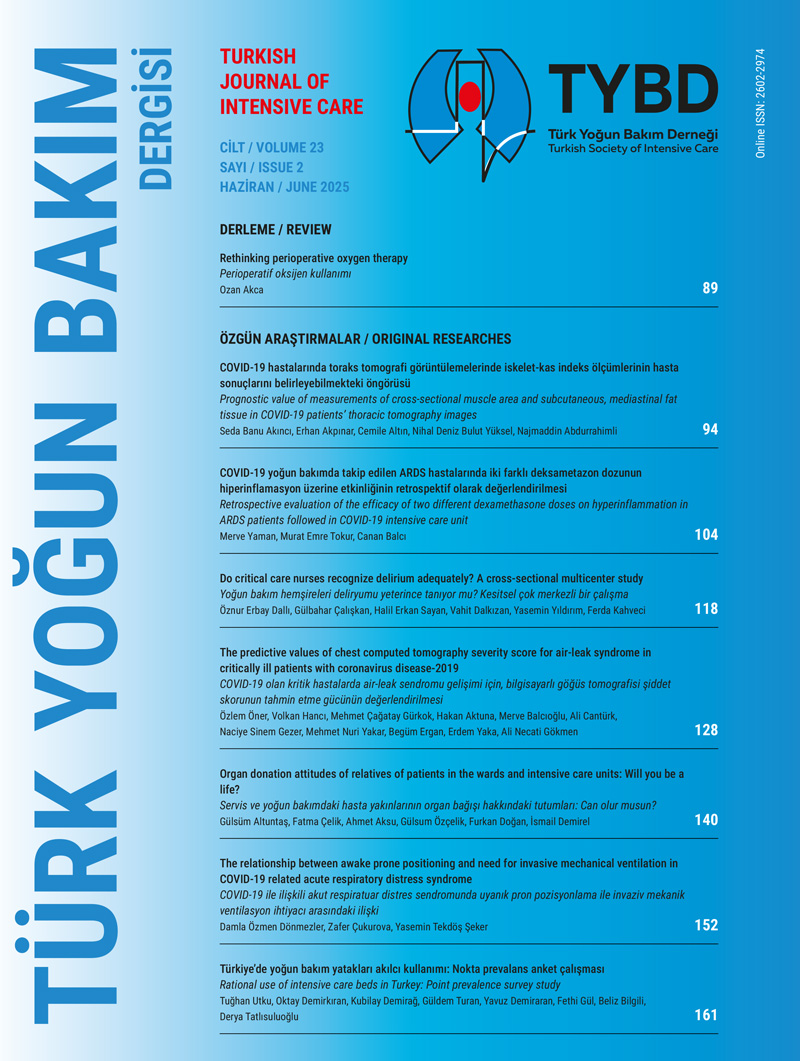Abstract
Objective: The limitation or withdrawal of futile treatment is widely accepted in the intensive care and medical ethics literature. However, implementing this in clinical practice is often difficult. The aim of the study is to understand the situation of non-indicated admissions and treatments in ICU beds in our country, as well as the doctors’ approaches to this issue.
Materials and Methods: The study is planned as a one-day point prevalence survey consisting of 35 questions (Google Survey form) to be conducted on January 18, 2024. The study is based on two main topics: the proportion of patients admitted to intensive care unit (ICU) without indication and the reasons for it, and the proportion of patients who receive futile treatment in the ICU, as well as identifying the views and recommendations of ICU doctors on these issues.
Results: A total of 127 doctors working in the ICU participated in the study. Among the participants, 58 reported that 10% of their patients, and 27 reported that 20% of their patients could not be transferred to the wards despite no longer needing ICU care. Due to the lack of available beds in the relevant clinics, 92 physicians stated that patient stays were extended by 1-5 days, and 21 physicians reported an extension of 6-10 days. In cases where transfer to palliative care services was not possible, 50 physicians indicated that 10% of their patients, 26 physicians indicated that 20%, and 21 physicians indicated that 30% of their patients remained in the ICU. Forty physicians reported a waiting time of more than 20 days for palliative care service. All physicians stated that futile treatments were being administered in the intensive care unit. Only 8.7% of the physicians reported that the patient was not in the terminal stage.
Conclusion: Useless treatment that prevents rational bed use in intensive care units; It is a preventable situation with solutions in the light of correct analysis of the problems.
Keywords: futility, indication of ICU, LOS in ICU, palliative care, intensive care
References
- Niederman MS, Berger JT. The delivery of futile care is harmful to other patients. Crit Care Med. 2010;38:S518-22. https://doi.org/10.1097/CCM.0b013e3181f1cba5
- Bagheri A, Asai A, Ida R. Experts' attitudes towards medical futility: an empirical survey from Japan. BMC Med Ethics. 2006;7:E8. https://doi.org/10.1186/1472-6939-7-8
- Sibbald R, Downar J, Hawryluck L. Perceptions of "futile care" among caregivers in intensive care units. CMAJ. 2007;177:1201-8. https://doi.org/10.1503/cmaj.070144
- Wilkinson DJC, Savulescu J. Knowing when to stop: futility in the ICU. Curr Opin Anaesthesiol. 2011;24:160-5. https://doi.org/10.1097/ACO.0b013e328343c5af
- Meltzer LS, Huckabay LM. Critical care nurses' perceptions of futile care and its effect on burnout. Am J Crit Care. 2004;13:202-8. https://doi.org/10.4037/ajcc2004.13.3.202
- Clarke CM. Do parents or surrogates have the right to demand treatment deemed futile? An analysis of the case of Baby L. J Adv Nurs. 2000;32:757-63. https://doi.org/10.1046/j.1365-2648.2000.01537.x
- Kasman DL. When is medical treatment futile? A guide for students, residents, and physicians. J Gen Intern Med. 2004;19:1053-6. https://doi.org/10.1111/j.1525-1497.2004.40134.x
- Winkler EC, Hiddemann W, Marckmann G. Evaluating a patient's request for life-prolonging treatment: an ethical framework. J Med Ethics. 2012;38:647-51. https://doi.org/10.1136/medethics-2011-100333
- Jox RJ, Schaider A, Marckmann G, Borasio GD. Medical futility at the end of life: the perspectives of intensive care and palliative care clinicians. J Med Ethics. 2012;38:540-5. https://doi.org/10.1136/medethics-2011-100479
- Schneiderman LJ. Defining Medical Futility and Improving Medical Care. J Bioeth Inq. 2011;8:123-31. https://doi.org/10.1007/s11673-011-9293-3
- Kadooka Y, Asai A, Fukuyama M, Bito S. A comparative survey on potentially futile treatments between Japanese nurses and laypeople. Nurs Ethics. 2014;21:64-75. https://doi.org/10.1177/0969733013484490
- Ferrell BR. Understanding the moral distress of nurses witnessing medically futile care. Oncol Nurs Forum. 2006;33:922-30. https://doi.org/10.1188/06.ONF.922-930
- Heland M. Fruitful or futile: intensive care nurses' experiences and perceptions of medical futility. Aust Crit Care. 2006;19:25-31. https://doi.org/10.1016/s1036-7314(06)80020-2
- Whitmer M, Hurst S, Prins M, Shepard K, McVey D. Medical futility: a paradigm as old as Hippocrates. Dimens Crit Care Nurs. 2009;28:67-71. https://doi.org/10.1097/DCC.0b013e318195d43f
- de Carvalho KK, Lunardi VL. Therapeutic futility as an ethical issue: intensive care unit nurses. Rev Lat Am Enfermagem. 2009;17:308-13. https://doi.org/10.1590/s0104-11692009000300005
- Öztaş A, İleri Fikri B, Aslancı Z, Turan G. Malignant Futility in the Intensive Care Unit. Turk J Intensive Care. 2024;22:281-8. https://doi.org/10.4274/tybd.galenos.2023.03880
- Sungurtekin H, Yalçın S. Evaluation of the End-stage Patients in Intensive Care. Turk J Intensive Care. 2023;21:248-53. https://doi.org/10.4274/tybd.galenos.2022.35219
- Jukić M, Šarić L, Prkić I, Puljak L. Medical futility treatment in intensive care units. Acta Med Acad. 2016;45:135-44. https://doi.org/10.5644/ama2006-124.169
- Aghabarary M, Nayeri ND. Reasons behind providing futile medical treatments in Iran. Nurs Ethics. 2017;24:33-45. https://doi.org/10.1177/0969733016638142
- Bahramnezhad F, Cheraghi MA, Salsali M, et al. Futile care; concept analysis based on a hybrid model. Glob J Health Sci. 2014;6:301-7. https://doi.org/10.5539/gjhs.v6n5p301
- Bagheri A. Regulating medical futility: neither excessive patient's autonomy nor physician's paternalism. Eur J Health Law. 2008;15:45-53. https://doi.org/10.1163/092902708x300181
- Mobasher M, Nakhaee N, Tahmasebi M, Zahedi F, Larijani B. Ethical issues in the end of life care for cancer patients in Iran. Iran J Public Health. 2013;42:188-96.
- Aghabarary M, Nayeri ND. Nurses' Perceptions of Futile Care: A Qualitative Study. Holist Nurs Pract. 2016;30:25-32. https://doi.org/10.1097/HNP.0000000000000128
- Aghabarary M, Dehghan Nayeri N. Medical futility and its challenges: a review study. J Med Ethics Hist Med. 2016;9:11.
- Yekefallah L, Ashktorab T, Manoochehri H, Hamid AM. Nurses' experiences of futile care at intensive care units: a phenomenological study. Glob J Health Sci. 2015;7:235-42. https://doi.org/10.5539/gjhs.v7n4p235
- Atashzadeh Shorideh F, Ashktorab T, Yaghmaei F. Iranian intensive care unit nurses' moral distress: a content analysis. Nurs Ethics. 2012;19:464-78. https://doi.org/10.1177/0969733012437988
- Mobley MJ, Rady MY, Verheijde JL, Patel B, Larson JS. The relationship between moral distress and perception of futile care in the critical care unit. Intensive Crit Care Nurs. 2007;23:256-63. https://doi.org/10.1016/j.iccn.2007.03.011
- Özden D, Karagözoğlu Ş, Yildirim G. Intensive care nurses' perception of futility: job satisfaction and burnout dimensions. Nurs Ethics. 2013;20:436-47. https://doi.org/10.1177/0969733012466002
- Palda VA, Bowman KW, McLean RF, Chapman MG. "Futile" care: do we provide it? Why? A semistructured, Canada-wide survey of intensive care unit doctors and nurses. J Crit Care. 2005;20:207-13. https://doi.org/10.1016/j.jcrc.2005.05.006
- Bishop JP, Brothers KB, Perry JE, Ahmad A. Reviving the conversation around CPR/DNR. Am J Bioeth. 2010;10:61-7. https://doi.org/10.1080/15265160903469328
- Kopar PK, Visani A, Squirrell K, Brown DE. Addressing Futility: A Practical Approach. Crit Care Explor. 2022;4:e0706. https://doi.org/10.1097/CCE.0000000000000706
- Anstey MH, Adams JL, McGlynn EA. Perceptions of the appropriateness of care in California adult intensive care units. Crit Care. 2015;19:51. https://doi.org/10.1186/s13054-015-0777-0
- Mercadante S, Gregoretti C, Cortegiani A. Palliative care in intensive care units: why, where, what, who, when, how. BMC Anesthesiol. 2018;18:106. https://doi.org/10.1186/s12871-018-0574-9
- Wang QL, Liu CR, Yue P, Han BR. Construction of Hospice Care Evaluation System for Terminally Ill Patients in ICU. Patient Prefer Adherence. 2024;18:29-37. https://doi.org/10.2147/PPA.S444290
Copyright and license
Copyright © 2025 The Author(s). This is an open access article distributed under the Creative Commons Attribution License (CC BY), which permits unrestricted use, distribution, and reproduction in any medium or format, provided the original work is properly cited.






















